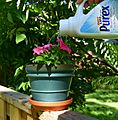Watering can facts for kids
A watering can is a handy tool used to give water to plants by hand. It's like a portable container, usually with a handle and a spout. People have been using watering cans for a very long time, since at least 79 A.D.! Over the years, their design has gotten better and better. Besides watering plants, these cans can be used for many other things because they are quite useful.
Watering cans come in different sizes. Small ones, about 0.5 litres, are great for plants inside your house. Bigger ones, up to 10 litres, are good for general garden use. They are usually made from materials like metal, ceramic, or plastic. At the end of the spout, there's often a special cap called a "rose." This rose has tiny holes that break the water stream into gentle droplets. This helps protect delicate plants and prevents the water from hitting the soil too hard.
Contents
History of Watering Cans
The name "watering can" first appeared around the 1000s. Before that, people often called it a "watering pot."
A very important step in watering can history happened in 1886. A man named John Haws created and patented a new type of watering can. He said his invention was "much easier to carry and tip." He also noted it was "much cleaner, and more adapted for use" than other designs at the time. This new design made watering plants much simpler for everyone.
The part of the watering can that looks like a shower head, with all the small holes, is still called the "rose" today.
What Watering Cans Are Used For Today
Watering cans are mostly used by gardeners to give water to their plants. They are a simple and effective way to make sure plants get the right amount of water. You might also see them used as pretty decorations in homes or gardens. Sometimes, artists even use them in their artwork to represent different ideas.
Watering Cans in Art
- The famous artist Pierre-Auguste Renoir painted a beautiful picture called A Girl with a Watering Can. It shows a young girl holding a watering can.
Gallery
-
A green, 2 litre watering can made of galvanised iron pouring water
See also
 In Spanish: Regadera para niños
In Spanish: Regadera para niños






